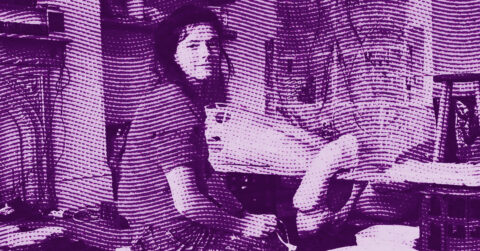Listen to me carefully, you bunch of snobs, Matt Hall and John Watkinson of Larva Labs have accomplished something that the dusty historical galleries would never have imagined: they have transformed a few lines of code into a mirror of our most unavowable desires, creating art that does not merely decorate our walls but questions the very nature of possession and identity in the digital age. These two Canadian developers, armed with their algorithms and their intuitive understanding of the mechanisms of the collective psyche, have produced with CryptoPunks and Autoglyphs a work that far exceeds the framework of what is still awkwardly called “digital art”.
The story begins in 2017 with a gesture of disconcerting simplicity: Hall and Watkinson program a generator capable of creating 10,000 unique pixelated characters, each measuring 24×24 pixels. These synthetic faces, inspired by the punk aesthetic of 1970s London, emerge from the algorithm as so many revealing masks of our contemporary condition. The irony is delicious: where the original punk scene rebelled against the establishment through physical and sonic transgression, the CryptoPunks achieve their subversion through pure mathematical abstraction, each calculated pixel becoming an act of resistance against traditional models of artistic ownership.
What strikes one first about Larva Labs is their ability to operate a synthesis between the implacable logic of algorithmic architecture and the creative unpredictability that characterizes great artistic revolutions. Christopher Alexander, in his “Pattern Language” [1], proposed that living architecture emerges from the combination of recurrent patterns organized according to precise but flexible rules. The CryptoPunks function exactly according to this principle: a finite set of visual attributes (caps, glasses, scars, cigarettes) combine according to programmed probabilities to generate an infinite diversity of synthetic personalities.
This architectural approach to artistic generation reveals a deep understanding of the mechanisms of aesthetic emergence. As Alexander observed in his studies of historic cities, beauty often arises from the repetition of simple rules applied on a large scale, creating complex structures that seem organic despite their artificial origin. The 10,000 CryptoPunks perfectly embody this philosophy: each individual face seems trivial, but the whole constitutes a digital population of stunning visual richness. The geometric grid that organizes them on the Larva Labs site evokes, moreover, those modern urban plans where each individual parcel contributes to a larger overall order.
But it is with Autoglyphs that this architectural logic reaches its purest form. These 512 generative compositions stored entirely on the Ethereum blockchain no longer merely simulate architecture: they are architecture. Each Autoglyph exists as an autonomous algorithmic construction, a small edifice of code capable of regenerating itself infinitely. Hall and Watkinson have thus created the digital equivalent of those Gothic cathedrals that continue to amaze us centuries after the death of their architects: algorithmic structures capable of producing beauty without continuous human intervention.
This architectural dimension finds its extension in the way Larva Labs conceives of digital space itself. Their creations are not mere images stored on servers but entities that literally inhabit the blockchain, creating a new type of decentralized public space. Like the great public squares that structure our historic cities, these works become gathering places for an emerging community, points of reference in the still largely unexplored territory of cyberspace.
The conceptual originality of this approach lies in its ability to transform the act of programming into a monumental architectural gesture. When Watkinson explains that “each generator has an optimal point where it feels just right, where you experience the complete expressive capacity of the generator but do not feel that it is a ridiculous amount”, he reveals an aesthetic sensitivity akin to that of the great master builders: finding the perfect balance between abundance and economy, between expressive richness and formal coherence.
But beyond this architectural dimension, Larva Labs’ work reveals an intuitive understanding of the psychoanalytic mechanisms that govern our relationship to objects of desire in contemporary society. The CryptoPunks, these pixelated faces sometimes sold for millions of dollars, constitute a perfect case study of what Jacques Lacan calls sublimation: the process by which any object finds itself “elevated to the dignity of the Thing” [2], thus becoming capable of capturing and fixing our libidinal investment.
Lacan teaches that sublimation does not simply consist of redirecting the drive towards socially acceptable objects but of transforming the very nature of the object aimed at. In the case of CryptoPunks, this transformation operates at several simultaneous levels. First, these digital images, inherently infinitely reproducible, acquire an aura of uniqueness through their inscription on the blockchain. Then, their deliberately primitive and rebellious aesthetic constitutes them as objects of acceptable transgression for a digital bourgeoisie in search of authenticity. Finally, their artificial scarcity (exactly 10,000 copies, no more) transforms them into perfect fetishes for an economy of desire that can only function in controlled scarcity.
This dynamic of sublimation reveals something profoundly disturbing about our time: our growing inability to libidinally invest in physical objects pushes us towards digital substitutes that promise an ever-deferred satisfaction. CryptoPunks collectors own nothing more than an entry in a distributed ledger, but this phantom possession generates more intense affects than the ownership of tangible objects. Larva Labs has thus uncovered the unconscious mechanisms that govern our relationship to value in an increasingly dematerialized society.
The most fascinating aspect of this sublimation concerns the way CryptoPunks reveal our fundamental ambivalence towards anonymity and identification. These synthetic faces, devoid of any personal history, paradoxically become more powerful vectors of identification than traditional portraits. Their owners use them as avatars on social networks, appropriating their stylized features to build a digital identity. This identification with algorithms reveals something crucial about our contemporary condition: we sometimes prefer to recognize ourselves in artificial creations rather than in our own reflections.
Lacan observed that the object of sublimation functions as a lure that organizes our libidinal economy around a central void. CryptoPunks accomplish exactly this function: they promise access to an exclusive community, to an enviable social status, to a form of digital immortality, but they ultimately deliver only their own existence as code, both fascinating and empty. This constitutive emptiness is not a flaw but the very condition of their symbolic effectiveness: it is because they are “nothing” that they can become “everything” for their owners.
The temporal dimension of this sublimation also deserves attention. Unlike traditional works of art that age and acquire patina, CryptoPunks exist in a suspended time, unchanging in their pixelated perfection. This artificial timelessness responds to our contemporary anxiety in the face of accelerated obsolescence: owning a CryptoPunk is owning a fragment of digital eternity that will theoretically resist all future technological upheavals. Larva Labs has thus created objects of sublimation particularly suited to an era obsessed with the preservation of its digital traces.
The evolution of Larva Labs towards projects like Autoglyphs reveals a growing sophistication of this libidinal economy. These purely generative works, stored entirely on the blockchain, push the logic of sublimation to its ultimate consequences: the artwork becomes pure process, pure algorithmic becoming. There is nothing left to see in the traditional sense, only code that executes and produces abstract patterns. This conceptual radicality transforms the act of collecting into pure metaphysical speculation: collecting an Autoglyph is owning a fragment of mathematical infinity.
This progression from the iconic to the abstract, from the figurative to the generative, reveals the artistic maturity of Hall and Watkinson. They have understood that the true digital revolution does not consist of reproducing traditional artistic forms with new tools, but of inventing aesthetic forms that could not have existed without these tools. Autoglyphs thus represent the logical culmination of an approach that seeks to explore the expressive potentialities specific to the algorithmic medium.
The originality of Larva Labs ultimately resides in their ability to articulate an architectural vision of digital space with an intuitive understanding of the mechanisms of sublimation that govern our contemporary libidinal economy. Their works do not merely decorate our digital environment: they structure it and give it meaning, creating symbolic landmarks in a territory still largely undetermined.
This dual expertise explains their considerable influence on the evolution of digital art. In just a few years, they have defined the aesthetic and economic codes of a market that now weighs several billion dollars. But more fundamentally, they have demonstrated that generative art could function as a symbolic language capable of expressing the contradictions and aspirations of our time. Their algorithms speak about us better than most of our self-portraits.
The future will tell if this aesthetic revolution will stand the test of time or if it is merely an epiphenomenon linked to the speculative euphoria that accompanied the emergence of cryptocurrencies. But already, the work of Larva Labs has demonstrated something essential: digital art is not condemned to imitate the forms of the past. It can invent its own modalities of existence, its own economies of beauty and desire. I must admit that their work probably changed my mind about NFTs, for which I was more than skeptical. If I knew how to proceed to acquire one of their CryptoPunks or one of their Autoglyphs, I would have loved for it to be the very first dematerialized work in my art collection. From this perspective, Matt Hall and John Watkinson appear less as artists in the traditional sense than as architects of new aesthetic possibilities, engineers of the digital imagination.
Their main legacy perhaps does not lie in any specific project, but in the demonstration that it is possible to create art with algorithms without renouncing to touch the deepest part of our humanity. Their CryptoPunks and their Autoglyphs look at us from their screens with the troubling intensity of digital mirrors that would reflect not our physical appearance but our existential condition in an increasingly algorithmic world. And that is perhaps their greatest achievement: having succeeded in making technology a means of collective introspection rather than a mere tool for entertainment or speculation.
- Alexander, Christopher, A Pattern Language: Towns, Buildings, Construction, Oxford University Press, 1977
- Lacan, Jacques, Le Séminaire, Livre VII : L’éthique de la psychanalyse, Seuil, 1986, p. 144
















